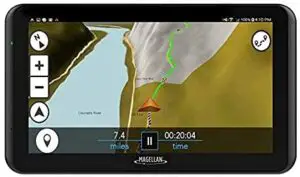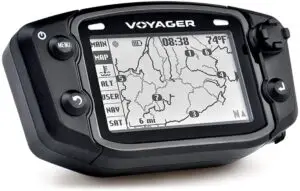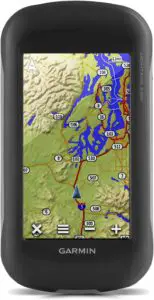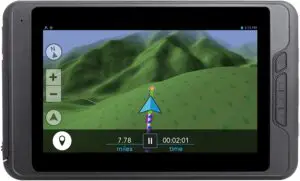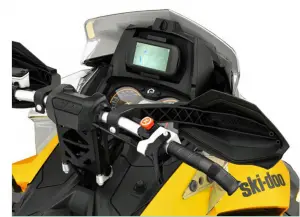
Global Positioning System (GPS) for snowmobiles has become an important navigational support for exploring unfamiliar trails. Residents of snowy areas frequently use snowmobiles for commuting across the trails, and tourists pursue their recreational freedom by hauling snowmobiles to the best trails in the area. In all cases, a GPS device is useful to find your way back to the trailer whether you are a mile from home in a snowstorm or testing out your snowmobile on a new trail.
Choosing the Best GPS for Snowmobiling?
While modern smartphones come with integrated GPS, it is better to get a dedicated device for snowmobiling. It has a longer runtime and works better in remote areas with weak cellular coverage. Here are a few suggestions that can assist you in choosing the best GPS for snowmobiling.
Preloaded Maps
Snowmobile riders must confirm if the GPS device comes preloaded with maps. Opt for a device that has all the maps of your preferred region for snowmobiling. At least the maps for your region should be available optionally. If it has all the latest maps, then you won’t have to download them. Another thing to keep in mind while buying a GPS device is future updates. Some GPS manufacturers allow you to download map updates for free. Others require you to pay a subscription for keeping the device up to date. Choose a model that offers free lifetime updates as it will be cost-effective in the long run.
Battery Operated vs. Electric GPS
There are both battery operated and electric GPS available for snowmobiling. While the former has a built-in rechargeable battery, the latter draws power from your snowmobile’s circuitry. A battery-operated GPS has a few advantages over its electric counterparts. It is portable and can be carried easily along. You can use it with other vehicles like a car as well. Its portability will be really beneficial in case you have to leave your sled behind and walk. On the other hand, an electric GPS is installed permanently. It will have to be hardwired with the circuitry of the snowmobile.
Battery operated GPS devices are the best for snowmobile riders. The best models have a runtime of several hours and will suit the requirements of most riders. If you are worried about the portable GPS running out of charge, then carry a few spare batteries with you. Consider Li-ion batteries over standard alkaline batteries. Alternatively, you can take a charger for the GPS that plugs into the 12V outlet on your snowmobile. It will enable you to recharge the GPS when its battery runs low.
Easy to Operate
The best GPS for snowmobiling is one that is easy to operate. It should navigate the route automatically and should rotate the map as per your orientation. The device’s interface must be clean and easily understandable. If you want to monitor additional parameters such as speed, direction, ETA, altitude, or ambient temperature, then consider a GPS that supports the same.
Offline Navigation
Most GPS devices come with a built-in SIM for accessing a mobile data network. However, a few of them can operate in offline mode. You can save the routes locally, and the device will navigate the route without the need for an active data connection. Offline navigation consumes significantly less battery and extends the runtime of the device. It can also be useful when the network coverage is poor in an area.
Data Logging
Data Logging is a handy feature to have in a GPS for snowmobiling. It allows you to track and save your route in the device as you navigate it. The same can be beneficial if you have to retrace your steps or save the route for future reference or analysis.
Portability
The GPS device that you are considering for snowmobiling must be portable. A compact model with a lightweight design will be the best fit for riders. It should fit compartments or pockets of backpacks easily. Having a highly portable GPS for snowmobiling is especially beneficial in case you have to walk to reach your destination or locate a cache. You should be able to mount the GPS on the handlebar with a bracket that is included in the package or available separately. There will be no need to hold the GPS in hand, and it will also be easily accessible.
Glove-Friendly Operation
You don’t want to remove gloves while riding a snowmobile in chilly weather just to operate your GPS. The heat trapped in the gloves will escape and make your hands stiff. Therefore, opt for a glove-friendly device when buying the best GPS for snowmobiling. You should be able to operate its touchscreen while wearing gloves easily. If it has buttons, the same should be glove-friendly as well.
Signal Reception
The GPS device must have excellent signal reception even in remote terrains. It should use advanced technologies for improving accuracy and tracking in unfavorable conditions. While some disruption is expected in extreme weather conditions or remote terrains, the GPS must function well most of the time. The update frequency of the device should be quick enough so that you stay on track.
Geocaching Support
Avid snowmobilers may want GPS devices with geocaching support. Many sled riders love to hide and find caches in their regions. They share the coordinates of their caches with other riders through GPX files. The activity is known as geocaching. These GPX files contain information such as waypoints, routes, and the exact location of geocaches. GPX files work with GPS devices that support geocaching. If you are an active participant in geocaching, then you may want to consider GPS models that support the same. A few models come with preloaded locations for geocaches.
Social Media Sharing
If you are a snowmobile rider who loves to explore the wilds and share the adventure with other riders, then you may want to consider a GPS device that supports social media sharing. They allow you to share the trail routes with fellow riders through social media platforms. Users can add audio or visual description for the waypoints on the trails. You can also check out the trails uploaded by other snowmobilers.
Miscellaneous Features
There are a few additional features that you can look for when selecting the best GPS for snowmobiling. It should have a backlit LCD screen of a decent size. You should be able to read it in sunlight easily. Some GPS devices come with a built-in camera. It allows you to take geotagged pictures that can be used for visually describing waypoints on trails. Consider a device with a camera if you need the same. The GPS device should be waterproof and designed to withstand harsh conditions.
Considering your GPS mounting options?
As discussed above, the best GPS for snowmobiling should be easily mountable and accessible. It is important to use a compatible mounting system for your snowmobile. Quite often, a GPS device will come with its mount, and you can also purchase the mounting accessories separately. The GPS device needs to be securely attached to your snowmobile so that it can withstand movements on all kinds of terrains. Most mounts come with suction cups and adhesives that you can use to install the system firmly in place. There are handlebar mounts that can clamp down on your snowmobile’s handlebar, and these are made for heavy-duty purposes. You can also find universal, swivel dash mounts that are adjustable, allowing you to view your GPS device from any angle.
Apart from a compatible mounting system, you should also consider securing your GPS device and mounting accessories against the weather. For example, you can buy a protective, water-resistant case to cover your GPS touchscreen. It will secure your device and still help you view the screen easily as you explore your favorite winter sport.
Best GPS for Snowmobiling – 2020
If you are searching for the best GPS for snowmobiling, there are many products available for purchase. The following are some of the best GPS for snowmobiling that we have found on the web:
1. Magellan TR7 Street and GPS Navigator (Model TN7771SGLUC)
With a 7-inch touchscreen of 800 x 400 resolution, the Magellan GPS navigator has been programmed to support trails throughout the 50 US States. It has a user-friendly interface to explore, download, and save routes for off-line navigation, as you will not require mobile data connection on the go. You can receive off-track updates and notifications, along with Backtrack routes to map your journey back to the starting point. TR7 allows you to share your experience and route via social media. It is operated with a Lithium Polymer battery.
2. Trail Tech Voyager Stealth Black Moto-GPS Computer (Model 912-119)
Voyager Snowmobile GPS has a growing reputation across its customer base. Apart from maps, the backlit LCD screen shows you the speed, distance, altitudes, navigational compass, and the temperature of your snowmobile’s engine. It has a MicroSD card, which is waterproof, to allow you to download trails and share them on social media. A smart data logging feature halts your trail logging when you turn off the engine. This GPS receiver is designed to optimize geolocation for all landscapes in snowy regions. It can be mounted securely to withstand complex maneuvers.
3. Garmin Montana 680t
With 250,000 preloaded geocaches from around the world, Garmin Montana provides resilient location services even in unfavorable terrains. The existing GPS is greatly enhanced by Wide Area Augmentation System (WAAS) and Global Navigation Satellite System (GLONASS). Hotfix satellite technology speeds up your device’s connection with the satellites. These features enable real-time topographic maps to facilitate your snowmobiling experience. You can use the track manager to easily manage your routes and waypoints. A built-in 8-megapixel camera on the Garmin Montana 680t GPS allows you to take pictures with geotagged data automatically updated into the images.
4. Magellan TRX7 Dual Mount Trail and Street GPS Navigator (Model TN1710SGLUC)
The TRX7 GPS Navigator provides a turn-by-turn visual and audio navigation for real-time updates along the way. You get access to several thousands of snowmobile trails across the USA and Canada. The device lets you follow a saved route that you added to favorites before or download from its database. You can view a 3D terrain map or a 2D topo version. The package includes a power cradle with USB cabling and a GPS mount bracket that is compatible with various snowmobiles. You can audio record a waypoint or select from the options and personalize its details with photos.
These were some of the best GPS for snowmobiling that we found, with the best ones featuring unique innovations that were previously only attainable with expensive equipment. They are a must-have for all snow journeys and mountain excursions to make sure that you do not get stranded in the middle of nowhere and that alternative routes are just a click away.
5. Trail Tech 922-122 Voyager Pro GPS Kit with Digital Gauge Trail Maps 4-Inch TFT LCD Touch Screen, Buddy Tracking, Handsfree Bluetooth

Trail Tech Voyager Pro is an ideal off-road GPS for snowmobiles. It has a 4-inch, anti-glare touchscreen, featuring an anti-dust/anti-water IP67 rating. This GPS unit is Bluetooth-enabled to support intercom, messaging, media control, and phone dialing features. You can access tachometer readings, maps, topography lines, trails, hill shading, tracks, routes, and waypoints. Voyager Pro offers a truly connected snowmobiling experience through colored navigation, topographic details, and preloaded North American maps. It allows you to download and share GPX trails using MicroSD cards. You can always download additional map regions – free of cost! The intuitive Buddy Tracking option is designed for connecting up to 20 snowmobilers through real-time locations, featuring an emergency beacon to reach out to them instantly. Since the user screen is customizable, you have the choice to set your own gauge readouts.
6. Garmin Tread Powersport Off-Road Navigator with Group Ride Radio, Group Tracking and Voice Communication, 5.5″ Display, 010-02406-00
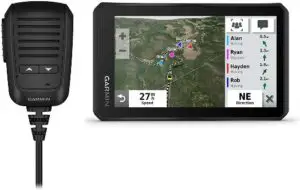
Garmin Tread Powersport GPS is a rugged, weather-resistant unit with an IPX7 rating. It has a glove-friendly and ultrabright touchscreen, mountable in both portrait and landscape orientations. The thermal and shock-resistant unit is equipped to handle challenging terrains. Its Group Ride Radio feature helps you communicate with your fellow snowmobilers using the convenient push-to-talk fist mic. Garmin GPS comes with preloaded topographic data for North America, including street maps, public land boundaries, trails, national forests, wilderness areas, landowner information, etc. The device lets you download BirdsEye Satellite Imagery without any annual subscription.
A compatible powered mount and wiring harness are included. You can also pair up the GPS navigator with your smartphone using the Tread app for accessing synchronized data and preloaded points of interest. Where permissible, the inReach satellite communicators can be used for 2-way messaging and interactive SOS. Furthermore, the navigator links with select Garmin GPS products to – for example – track your dog or maximize your snowmobile’s visibility.
